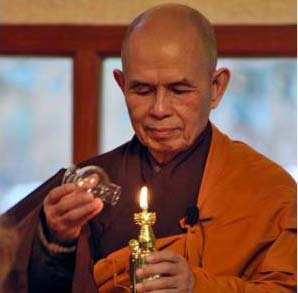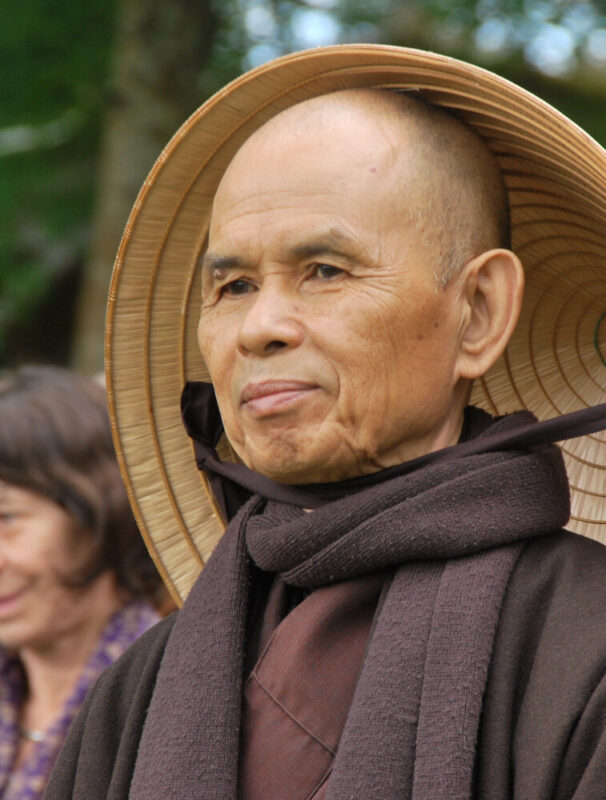by Elizabeth V. Hallett
High Ceremony is being observed around the world to honor the passing of revered teacher and spiritual leader Thich Nhat Hanh who died precisely at midnight on January 22, 2022. Live coverage of the ceremonies are available on YouTube.
We enclose two articles offering different approaches to a review of the life of the beloved “Thay” (Thay is Vietnamese for teacher) including one from Triangle Magazine and another from the National Catholic Reporter.
This peace warrior began his years as a Buddhist monk in the crucible of the Vietnamese social and political upheaval of his time. Having made his first foray into the United States studying comparative religions at Princeton in 1961, Thich Nhat Hanh was invited back to the United States in 1966 by the National Fellowship of Reconciliation (FOR), of which Dr. Martin Luther King, Jr. was a member. (FOR was the parent sponsor for Peace House for many years until we established our new nonprofit in the 1990’s.) While in the US, Thay lectured at Cornell and Columbia Universities. He met with Dr. King as well as the Trappist monk Thomas Merton and was quickly recognized by both of them as an authentic and powerful spiritual force.
 During that time, he asked Dr. King to speak out against the war in Vietnam, which laid the groundwork for a new and shocking stance on the part of Dr. King, in his famous and prophetic speech at the Riverside Church in New York City on April 4, 1967. The speech broadened Dr. King’s own call for nonviolence while alienating many in the civil rights movement. Thich Nhat Hanh also asked then US Secretary of Defense Robert MacNamara to stop bombing Vietnam.
During that time, he asked Dr. King to speak out against the war in Vietnam, which laid the groundwork for a new and shocking stance on the part of Dr. King, in his famous and prophetic speech at the Riverside Church in New York City on April 4, 1967. The speech broadened Dr. King’s own call for nonviolence while alienating many in the civil rights movement. Thich Nhat Hanh also asked then US Secretary of Defense Robert MacNamara to stop bombing Vietnam.
As the recent article in Tricycle explained, “after leaving the United States, Thay returned to Europe, where he had an audience with Pope Paul VI. The two religious figures urged greater cooperation between Catholics and Buddhists to help bring about world peace, starting with ending the conflict in Vietnam.” Together, they forged new bonds between Christian and Buddhist communities around the world.
It is significant that just as Thich Nhat Hanh received the Dharma transmission, becoming a teacher in the forty-two generation Lieu Quan dharma lineage, he was banned from returning to his homeland and spent the next thirty-nine years in exile. His uncompromising stand for nonviolence endured the fires of exile and discrimination in some quarters for the rest of his life, as he wove his revitalized Buddhist teachings into communities around the world. At the time he was eschewing the traditional Buddhist thinking that political involvement was not acceptable politically, spiritually or socially in Vietnam. What the young monk called “engaged Buddhism” was considered to interfere with spiritual development. His resistance to war-making was seen as a betrayal and he was branded a communist for seeking nonviolent means to conflict resolution.
At the time he was eschewing the traditional Buddhist thinking that political involvement was not acceptable politically, spiritually or socially in Vietnam. What the young monk called “engaged Buddhism” was considered to interfere with spiritual development. His resistance to war-making was seen as a betrayal and he was branded a communist for seeking nonviolent means to conflict resolution.
Thich Nhat Hanh’s anti-war activism and refusal to take sides angered both North and South Vietnam, and following his tour of the US and Europe, he was barred from returning to his native land. He was granted asylum in France, where he was named to lead the Buddhist peace delegation to the Paris Peace Accords (1969-1973) and founded the famed Plum Village Monastery. During his time abroad, he also founded eight other monasteries, including Deer Park in California. He was finally allowed to return to Vietnam in 2005, and would later live out his remaining years after a stroke in 2014 until his death at his root monastery in the city of Hue.
Thay may have been best known for founding nine monasteries, instructing students in mindfulness trainings, composing poetry, and for the establishment of the Order of Interbeing in Saigon in 1966. People of all walks of life and religious affiliations have been touched by Thich Nhat Hanh’s prolific work and he will be revered for time immemorial.


